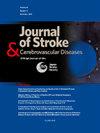Stroke severity and prognosis in patients on the brink of end-stage chronic kidney disease: K-PLUS registry
IF 1.8
4区 医学
Q3 NEUROSCIENCES
Journal of Stroke & Cerebrovascular Diseases
Pub Date : 2025-07-05
DOI:10.1016/j.jstrokecerebrovasdis.2025.108391
引用次数: 0
Abstract
Background and purpose
The association between chronic kidney disease (CKD) grade and stroke severity or prognosis is still controversial. We investigated the relationship between CKD stage and stroke severity on admission and its influence on prognosis.
Methods
Using a regional stroke registry, the clinical characteristics of acute ischemic stroke patients were investigated in each CKD stage (G1–G5). The relationship between CKD stage and the National Institutes of Health Stroke Scale (NIHSS) score was examined in stratified analyses under the presence or absence of various factors. Multiple logistic regression analyses to identify predictors for an unfavorable prognosis or death were performed.
Results
Of 10,104 patients, 1,056 (10 %) were CKD stage G1, 3,797 (38 %) were stage G2, 4,137 (41 %) were stage G3, 678 (7 %) were stage G4, and 436 (4 %) were stage G5. The NIHSS score was the highest in patients with stage G4 (median, 10; interquartile range, 4–22), compared to those with G1 (3; 1–8), G2 (3; 2–9), G3 (6; 2–16), and G5 (5; 2–14). Similar results were obtained on multiple logistic regression analysis including potential confounders. As to outcome at discharge, a modified Rankin Scale score of ≥3 was more frequently observed in stage G4 patients. However, the independent relationships diminished after multiple logistic regression analyses including stroke severity on admission as an independent variable.
Conclusion
Stroke severity on admission was the highest in patients with CKD stage G4 compared to the other stages, which was possibly related to an unfavorable prognosis and mortality.
终末期慢性肾病患者中风严重程度和预后:K-PLUS注册
背景与目的:慢性肾脏疾病(CKD)分级与脑卒中严重程度或预后之间的关系仍存在争议。我们探讨CKD分期与入院时脑卒中严重程度的关系及其对预后的影响。方法:采用区域性卒中登记,研究急性缺血性卒中患者CKD各阶段(G1-G5)的临床特征。在存在或不存在各种因素的情况下,分层分析CKD分期与美国国立卫生研究院卒中量表(NIHSS)评分之间的关系。进行了多重逻辑回归分析,以确定不良预后或死亡的预测因素。结果:10104例患者中,CKD G1期1056例(10%),G2期3797例(38%),G3期4137例(41%),G4期678例(7%),G5期436例(4%)。NIHSS评分在G4期患者中最高(中位数,10;四分位间距,4-22),与G1组相比(3;1-8), g2 (3);2-9), g3 (6);2-16), G5 (5;2 - 14)。包括潜在混杂因素在内的多重逻辑回归分析也得到了类似的结果。至于出院时的预后,改良Rankin量表评分≥3分在G4期患者中更为常见。然而,在包括入院时中风严重程度作为自变量的多重逻辑回归分析后,独立关系减弱。结论:CKD G4期患者入院时脑卒中严重程度最高,可能与预后及病死率较差有关。
本文章由计算机程序翻译,如有差异,请以英文原文为准。
求助全文
约1分钟内获得全文
求助全文
来源期刊

Journal of Stroke & Cerebrovascular Diseases
Medicine-Surgery
CiteScore
5.00
自引率
4.00%
发文量
583
审稿时长
62 days
期刊介绍:
The Journal of Stroke & Cerebrovascular Diseases publishes original papers on basic and clinical science related to the fields of stroke and cerebrovascular diseases. The Journal also features review articles, controversies, methods and technical notes, selected case reports and other original articles of special nature. Its editorial mission is to focus on prevention and repair of cerebrovascular disease. Clinical papers emphasize medical and surgical aspects of stroke, clinical trials and design, epidemiology, stroke care delivery systems and outcomes, imaging sciences and rehabilitation of stroke. The Journal will be of special interest to specialists involved in caring for patients with cerebrovascular disease, including neurologists, neurosurgeons and cardiologists.
 求助内容:
求助内容: 应助结果提醒方式:
应助结果提醒方式:


